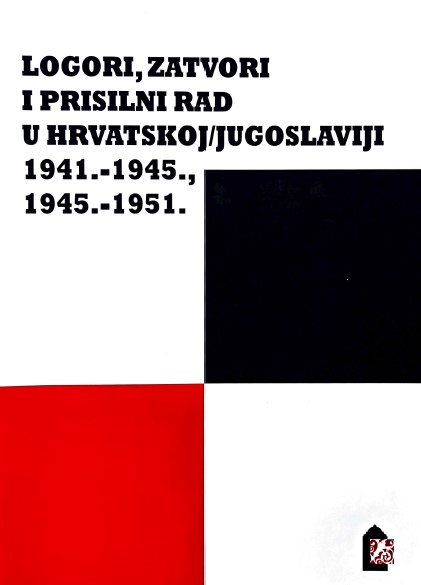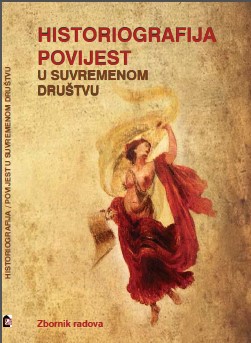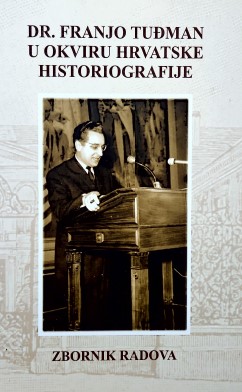
We kindly inform you that, as long as the subject affiliation of our 300.000+ articles is in progress, you might get unsufficient or no results on your third level or second level search. In this case, please broaden your search criteria.








In this paper a hypothesis has been discussed that during a certain period of time at the beginning of 19th century at the tekke of Salaheddin baba (which turbe has been built by the famous Osman Pazvantoglu in the town of Vidin in 1801), there was a book collection or a library. This case study has been examined in the context of several topics: 1) the history of the town of "Islam serhad" Vidin; 2) Osman Pazvantoglu and his family; 3) Osman's activity in the field of Islamic charity and his building works; 4) the cult of Muslim Martyrs, precisely of "late" sehids, and the image of sehid Salaheddin/Salatin baba, killed in the battle when the Austrians besieged the Vidin castle in 1689; the tekke is mentioned in documents as a tekke, baba hanegah, zaviye, dergah and financially was supported in the 19th century by the vakf of Osman Pazvantoglu; according to the Muslim' folklore from Vidin his turbe became a worship place and Salaheddin was honoured as a healer; 5) the library of Osman Pazvantoglu; 6) Data found in the Catalogue of the Osman Pazvantoglu's Library from 1837 and in a manuscript from the same library, support the hypothesis of the existence of a book collection or a library in the tekke of Salaheddin baba, the books of the tekke have been moved to the public library of Pazvantoglu probably before 1837. The collection consisted of 30 manuscripts, 11 of which were described in the section "Sufizm, moral and sermon" of the Catalogue from 1837.
More...


Neka od najtežih kršenja ljudskih prava mogu počiniti one institucije države čija je zadaća i svrha postojanja zaštita građana od nasilja i nepravdi. U pravnoj državi te institucije su, prije svega, policija i sudovi. Postupci korumpiranih policajaca i sudaca s pravom se doživljavaju kao posebno nepravedni i nemoralni. Ljudi koji su školovani i plaćeni da nepravde spriječe i ispravljaju, koriste se svojim znanjem i položajem da nepravdu ozakone i, često, da joj daju svoj doprinos. Pod korumpiranošću se obično podrazumijeva pristrano postupanje protivno pravilima i zakonima na koje se osoba javno poziva i koje je prema svom položaju dužna poštovati zato što je podmićena novcem. Osim materijalnog koristoljublja, pristrano postupanje protivno postojećim pravilima, zakonima i moralnim načelima može biti potaknuto sviješću da je takvo postupanje politički podobno, a da je ostajanje pri moralnim načelima nezdravo za karijeru. Taj oblik ‘’legalizirane korupcije’’ mnogo je opasniji jer predstavlja bolest društva, a ne samo izolirane slučajeve nepoštenih i nemoralnih pojedinaca.
More...
Sažeto rečeno, svrha kaznenih sankcija sastoji se od posebne i opće prevencije te od retribucije/kažnjavanja društva počinitelja kaznenih djela. U suvremenim pravnim porecima zapadnog tipa, težište se pomaknulo na preventivni element kaznenog sankcioniranja radi odvraćanja od činjenja budućih kaznenih djela i s težnjom resocijalizacije počinitelja, iako osuda i kazna ostaju sastavni dio izricanja kaznenih sankcija.
More...
Restrictions to freedom and forced labour in the Croatian, that is Yugoslavian, legal system following the Second World War, during the period of “National Democracy,” was determined by a series of decrees, resolutions, and laws. From 1945 to 1951, the Yugoslavian penal code recognized four types of non-free labour: forced labour without the removal of personal freedom, forced labour with restrictions to personal freedom, corrective work and socially useful work. This article, on the basis of sources, literature, and above all the most important decrees, resolutions, and laws applied in Croatia, and elsewhere in Yugoslavia, during the period of “National Democracy”, from 1945-1951, reviews the matter of state repression and the question of the restrictions to freedoms and forced labour in the penal code.
More...
Forced labour in Serbia, in the first postwar years, appeared in specific situations and affected various social groups, and it was carried out in the conditions of revolutionary political change. During the time of liberation and immediately afterward “mobilization” appeared as a specific form of required labour, while in the later period work referred to as “required service” or “required work” received special significance. Failure to comply with these orders carried sanctions in terms or criminal or administrative penalties. Specific social categories, the war prisoners and Volksdeutsche (ethnic Germans), who li-ved in camps were employed as forced labour and their freedom was restricted as a whole; other social categories were required to work through judgments of the courts and these sentences could be applied in jails or in freedom; a third type of required labour, which affected groups such as pensioners, occurred due to a lack experts, requiring them to accept various jobs in order to maintain their pensions. Regardless of the type of category, forced labour was in fact mobilized free labour, which was employed in numerous construction sites, mines, or other objects in fulfillment of the first Five Year Plan.
More...
Author analyzes discursive praxis in confronting the past and reasons why such approach is considered as a stabilizing concept within historiography. The example of holocaust and its implementation within national and transnational memory of the entire humankind shows how history and memory coexist. Namely, a historiography is inspired by a new model of ethical awareness that imposes revealing of a negative memory in order to avoid repetition and manipulation of the remembrance, especially regarding possible retroactive justification of historical crimes. Generally speaking, such a concept of confronting the past opens question about “negative memories”, and maintains idea that not speaking about historical evil enables its possible return in the future. From the perspective of historical memory one can say that historiography today emphasizes its ethical orientation. Historians today do not have a monopoly on interpreting the past, and this fact enables dialogue between historiography and other scholarly disciplines. Namely, during the last twenty years many sociologists, anthropologists, psychologists, literary scholars and philosophers contributed a lot in the investigation of contradictions and anomalies that accompany transformation of a living communicated remembrance to the commemorative and institutionalized memory. The question of transformation of individual remembrance to collective memory is rather well investigated in the relation to the meaning and significance of social obligation towards a social group, especially regarding question of merging or debarring of certain memories. Author also points out some examples of making the memories in Croatia during the transition period in 1990s’. Moreover, question of rememorizing the World War Two (1941-1945) is discussed in comparison to the rising of social importance of the remembrance of the Homeland War (1991- 1995), especially in the relation to the decisions of the International Criminal Tribunal for the former Yugoslavia. The fall of the Berlin wall in 1989 and collapse of communism in the Central and South-Eastern Europe provoked numerous nationalistic re-interpretations in the small local historiographies. Consequently, some of the Croatian historians during 1990s’ treated their nation as a victim, and confronting the past was rather strongly present in the investigation of victims of communism 1945- 1990, which was necessary at that time because of the need to create a social balance. Nowadays some recent studies show that Croatian historians are more open towards new theoretical approaches within the research field of culture of remembrance. Finally, there is an open question of memorial function of the Homeland War 1991-1995. Namely, many analysts think that international justice has failed in the case of processing crimes during the Yugoslav war. If the International Court of Justice took more clear and undisputable position regarding crime against peace that was committed by Milošević’s Serbia during the aggression to Croatia and Bosnia and Herzegovina, we could do much more effective work regarding negation of mass crimes and recurrence of genocide in Europe.
More...
After the collapse of the second Yugoslavia all the official bonds that Croatian historiography had with other former Yugoslav historiographies were broken. Still, the cooperation among historians was soon renewed, especially between Croatian and Serbian historians through participation on the international scholarly conferences called Dijalog povjesničara / istoričara (Dialogue among historians) organized by Foundation Friedrich Naumann. During eight years (1998-2005) the foundation organized 10 conferences, and published the conference proceedings. These conferences managed to gather 165 participants (from twelve different countries), who delivered their papers and worked in the form of workgroups. The most important part of these conferences is the fact that they were organized without any political influence, though many participants emphasized idea of international and internal reconciliation project. However, this reconciliation does not include political reconciliation but only reconciliation with the past. Throughout the years, these conferences showed that historians from both countries can cooperate and exchange ideas without any significant problem but only in the framework of a scholarly dialogue.
More...
Ivo Pilar, Ph. D., (1874-1933), attorney-at-law, completed his brochure The World War and the Croats (Svjetski rat i Hrvati) in March 1915. It was published in Zagreb that same year. Knowing that the authorities of the Austro-Hungarian Monarchy would not be pleased with some of his theses, Pilar published the brochure under the pseudonym Dr. Juričić. The author’s fears of a possible negative reaction to his geopolitical ideas were not ungrounded, since the state’s censor abridged Pilar’s original text thoroughly before he allowed it to be published. The second edition of Pilar’s brochure, containing many sentences that had been censored out of the first edition, most of them pertaining to the Central Forces’ unfaithful ally Italy, was published two years later. In his analysis of the political situation at the beginning of World War I, Pilar concluded that the times were fateful for the Croatian people, since the outcome of the war was going to decide with which country the Croatian territories would side in the long run. Tuđman felt that Pilar’s views were a reflection of the ideas of all the factions in Croatian politics that sought to solve the Croatian national question within the confines of the Austro-Hungarian Monarchy and within the Central European geopolitical territory. Even though Pilar’s basic hypothesis had proved wrong (he assumed Germany and Austro-Hungarian Monarchy would win World War I), some of his ideas, particularly the ideas about the geopolitical position of Croatian territories and their historical fate, still hold their original value.
More...
Early in May 1914, when official news about Archduke Francis Ferdinand’s military manoeuvres in Bosnia appeared in the Croatian newspapers, no one could have guessed that the tragedy of World War I was imminent. Although tensions between Austria-Hungary and the Kingdom of Serbia had been growing since the annexation of Bosnia and Herzegovina and the Balkan turmoil, few were predicting an escalation of the conflict in a domino effect. Assassination of the Crown Prince and his wife Sofia on June 28, 1914, in the capital of Bosnia and Herzegovina, led to the outbreak of a war in which the political map of Europe would be redrawn. The struggle for European supremacy between two blocs of states brought to the fore major military and foreign policy is-sues, in which smaller nations without their independent states had to demonstrate their ability to survive. In Croatia, the political public unanimously condemned the terrorist act of the Yugoslav revolutionaries gathered in the organization Young Bosnia (Mlada Bosna). It was committed on Vidovdan, a significant religious holiday for the Eastern Orthodox Serbs commemorating the notorious defeat of medieval Serbia in a conflict with the Ottoman Empire in Kosovo and symbolizing hope in revenge. Further developments were expected, in which the Croats could not play a significant role due to the underrepresentation of the Croatian elite in the leading positions in Austro-Hungarian key institutions: the governments of both countries, various ministries from foreign affairs to public finances, and the army.
More...
The duration and intensity of warfare in Yugoslavia and the Independent State of Croatia, the presence of significant occupation forces of the German Reich, Italy, and Hungary, and the activities of NDH Army, the Yugoslav Army in the Homeland (the Chetniks), and the People’s Liberation Army and the Partisan Detachments of Yugoslavia / Yugoslav Army resulted in direct conflicts between the warring parties, which led to severe human losses among the soldiers and civilians alike. The irreconcilable ideologies and political and military interests in the armed conflict and the civil war multiplied the casulaties.
More...
Shqiptarët e Rumanisë janë një pakicë etnike që, sipas përfundimeve të regjistrimit të popullsisë të vitit 2002, numuron 520 vetë. Por shifra e vërtetë e tyre besohet të jetë rreth 10.000. Kjo mospërputhje lidhet me faktin që jo pak shqiptarë etnikë vetëdeklarohen rumunë. Afro gjysma e tyre banojnë në qendra të rëndësishme urbane, si: Timishoara, Jash, Konstancë dhe Kluzh-Napoka. Shumica janë të krishterë ortodoksë, të ardhur gjatë shekujve nga Jugu i Shqipërisë, kryesisht nga Korça, por ka edhe myslimanë, kryesisht në Dobruxhë, në rrethinat e portit të Konstancës.
More...